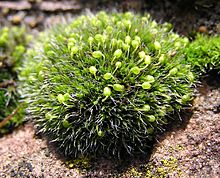Cryptogam


Pelvetia canaliculata
, a brown alga
A cryptogam (scientific name Cryptogamae) is a plant (in the wide sense of the word) or a plant-like organism that reproduces by
seeds
.
Former group
The name Cryptogamae (from
Cyanophyta.[3] The classification is now deprecated in Linnaean taxonomy. Cryptogams have been classified into three sub-kingdoms: Thallophyta, bryophytes, and Pteridophyta.[3]
Not all cryptogams are treated as part of the
plant systematics, "Cryptogamae" is not a taxonomically coherent group, but is polyphyletic. However, the names of all cryptogams are regulated by the International Code of Nomenclature for algae, fungi, and plants
.
In human culture
An
cryptograms.[4][5][6] However, the story is a myth; though Tandy did indeed work at Bletchley, he was not recruited by mistake. At the time the field of cryptography was very new, and so it was typical to hire those with education and expertise in other fields.[7]
References
- ISBN 0-05-002485-X.
- Royal Botanic Garden, Edinburgh. Archived from the originalon 2007-11-18. Retrieved 2007-07-02.
- ^ McGraw-Hill.
- ^ Smithies, Sandy (19 January 1999). "Television Tuesday Watching brief". The Guardian. Retrieved 23 July 2015.
- Station X". Birmingham Post.
- ^ Hanks, Robert (20 January 1999). "Television Review". The Independent.
- ^ Knighton, Andrew (2018-05-27). "The Debunked Yet Interesting Myth About How Seaweed Apparently Helped Break the Enigma Code". warhistoryonline. Retrieved 2024-05-13.
External links
- . Encyclopædia Britannica. Vol. 1 (11th ed.). 1911. p. 155.
